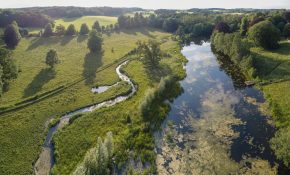White-clawed crayfish
About
The white-clawed crayfish (Austropotamobius pallipes) is the UK’s only native species of freshwater crayfish and is also our largest freshwater crustacean. It lives in a diverse variety of clean freshwater habitats, tending to prefer calcium-rich, shallow waters containing stones and over-hanging vegetation to protect it from predators. Described as an ecosystem engineer – a species that creates, maintains or modifies a habitat – the crustacean plays an important role in maintaining our watercourses.
Sadly, white-clawed crayfish have declined dramatically in recent years, with the species listed as ‘endangered’ throughout its range (IUCN Red List of Threatened Species).
Discover more about this species:
Threats to white-clawed crayfish
The white-clawed crayfish is threatened by:
- Crayfish plague, a fungal infection that is lethal to white-clawed crayfish and spread by invasive species and water equipment.
- Non-native crayfish, such as the American signal crayfish, that outcompete native crayfish by predation and direct competition for food.
- Poor water quality and pollution incidents (sewage discharges, agricultural and urban run-off and chemical discharges from industry, as well as flea and tick treatment from dogs and cattle when introduced to watercourses).
- Habitat loss and deterioration.
Working to protect our native crayfish
The Norfolk Crayfish Group – made up of Norfolk Rivers Trust, the Environment Agency, Water Management Alliance, Norfolk Non-Native Species Initiative, the Zoological Society of East Anglia (ZSEA) and a number of other individuals and independent organisations – work together to conserve native crayfish populations by:
- Enhancing habitat – for example, creating in-water refuges along riverbanks and margins using materials such as brash bundles.
- Improving water quality – our Water Sensitive Farming team work closely with farmers and landowners to reduce pollution from farms.
- Establishing a hatchery – working in collaboration, Norfolk Rivers Trust and the ZSEA have set up a hatchery to breed white-clawed crayfish. Once the young crayfish have reached a suitable size, they will be used to stock safe ‘ark sites’ (an isolated refuge area away from threats) where new populations can be established.
- Identifying suitable locations for ‘ark sites’.
Despite ongoing research, there is currently no known method of controlling non-native crayfish. This puts emphasis on the importance of stopping the spread of the crayfish plague and maintaining the current white-clawed crayfish populations until an effective management technique has been found.

Enhancing crayfish habitat

Crayfish hatchery
How you can help
Norfolk is one of the last known strongholds for white-clawed crayfish. Join the battle to safeguard this species:
- Reduce your water and chemical use around the home.
- Empty your septic tank annually.
- Keep dogs and livestock (treated with flea and tick treatment) away from the river.
- Disinfect and thoroughly dry canoes, kayaks and fishing equipment before each use – follow the ‘Check Clean Dry’ biosecurity protocol.
- Keep woody debris such as logs and trees in the river to improve habitat for native crayfish.
- Leave bank margins unmown and ungrazed.
- Don’t pour anything down road drains as many of them directly lead to rivers – “Only Rain Down the Drain”.
Illegal trapping
In Norfolk, it is not permitted to trap crayfish due to the risk of catching native crayfish, spreading crayfish plague and trapping and killing water voles or otters.
Trapping is only permitted by licensed crayfish ecologists for scientific purposes. It is illegal to move American signal crayfish and trapping them has been proven by a number of studies to be ineffective.
If you spot a crayfish trap in a watercourse, please report it immediately by calling 0800 80 70 60. Please provide a grid reference or what3words location.
Identification
If you discover a crayfish and would like some help identifying it, please feel free to email photos to [email protected]. It is essential to get photos of the “claws”, “nose” and “cheeks”, noting whether the crayfish was out during the day and where it was found.
Useful resources
Two brilliant interactive story maps have been produced by the Yorkshire Wildlife Trust, providing a wealth of information on white-clawed crayfish:






